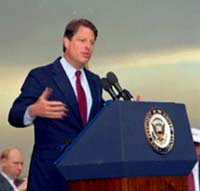Like the nine-foot-deep blanket of ice at the top of the world, America’s denial of the climate crisis is melting.

In hot water in the Antarctic.
Photo: Michael Van Woert, NOAA.
And like the North Pole, it is melting from the top down.
Over the last year, in the wake of steady alarms from leaders of the insurance industry, growing numbers of oil and auto company executives have been undergoing a quiet but profound sea change in their responses to global warming.
At long last, that change is rapidly engulfing the general public.
The most formidible fortress of denial remains at the center of the country’s political establishment, where campaign strategists and spin-meisters have insulated the presidential candidates from the increasingly harsh outcries of nature.
The Climate, It Is A-Changin’
When James McCarthy of Harvard University, cochair of a working group for the Intergovernmental Panel on Climate Change, announced his discovery last month of a mile-wide stretch of open water at the North Pole, it triggered a national catharsis. Despite controversy over the uniqueness of the polar meltdown, the finding loosed a barrage of pent-up fears about climate change that have been building just below the surface of public discourse.
From Time magazine to the New York Times to the Late Show with David Letterman, commentators began weighing in. Some of the dismay may be a bit overstated. The melting at the pole is, after all, only one more piece of confirmatory evidence of what is happening to the planet. But coming on the heels of an accumulation of findings about the heating of the oceans, the break-up of Antarctic ice shelves, the melting of glaciers, the thawing of the tundra, the changing timing of the seasons, and the warming-driven spread of infectious disease, the news from the far north has at long last galvanized public opinion.

Sizzlin’ cities.
The corporate community, ever alert to future impacts on global commerce, has already begun to anticipate the implications of the climate crisis.
The property insurance industry, especially in Europe, has led the charge with a drumbeat of alarms over the increasingly severe losses due to extreme weather events. In the 1980s, the industry lost an average of $2 billion a year because of floods, droughts, and intense storms. For most of the 1990s, that figure increased more than sixfold, exceeding $12 billion a year. The $89 billion in losses just in 1998 surpassed the total of all such losses for the entire decade of the 1980s. The head of the Reinsurance Association of America has said that unless the climate is stabilized, it could bankrupt the entire industry.
For their part, the oil and auto industries have ventured tentatively into clean energy technologies — partly to improve their public images, but partly to prepare themselves for the inevitable new energy economy.
Mazda recently joined Ford and Daimler-Chrysler in a $1 billion joint venture to produce fuel-cell powered cars by 2003. British Petroleum’s new ads portray BP as standing for “Beyond Petroleum.” BP now anticipates doing $1 billion a year in solar commerce within the decade, and Shell is investing $500 million in renewable technologies.
Since December, the Global Climate Coalition, the main industry group opposing action on global warming, has seen its membership hemorrhage as Ford, DaimlerChrysler, General Motors, Texaco, the Southern Company, and others have defected from the group. (The last major holdout — ExxonMobil — has become increasingly isolated in the oil industry.)
Even more telling was a little-noticed vote in January at the World Economic Forum in Davos, Switzerland. At the conclusion of this year’s Forum, which includes the CEOs of the world’s 1,000 largest corporations as well as many heads of state and finance ministers, participants were asked to vote on which of five scenarios (involving issues of trade and globalization) were most threatening. The participants rejected those choices and voted climate change as the most urgent problem facing humanity.
Soon thereafter came an extraordinary public acknowledgement from William Clay Ford, chair of Ford Motor Co., that the same SUVs that provide the company’s largest profit margins are also contributing to the destabilization of our climate. That statement set off a competition between Ford and General Motors to make promises about producing more fuel-efficient vehicles.
By contrast, diehard deniers of climate change like ExxonMobil and the coal-touting Western Fuels Association look downright presidential.
Not Al He’s Cracked Up to Be
Al Gore, who cast a spotlight on global warming in 1992 with his heartfelt book Earth in the Balance, has turned his back on the issue.

Little trees won’t solve big problems.
Photo: Steve Holmer, American Lands.
In July, the White House proclaimed that the U.S. can meet much of its obligation to reduce emissions by planting trees rather than by moving the country away from coal and oil to high efficiency and renewable energy. That announcement was Gore’s preemptive defense against the expectation that George W. Bush will attack him by citing the call in Gore’s book to phase out the internal-combustion engine. The new White House policy lets Gore shun that position in favor of more tree plantations. That strategy is akin to prescribing a manicure to a cancer patient.
Gore again turned his back on the climate issue when he asked President Clinton to release millions of barrels of oil from the Strategic Petroleum Reserve last week. While election-year pressures may have required him to open the tap to lower heating oil prices, Gore could have used the occasion to highlight the negative impacts of fossil fuels and announce a long-term energy policy based on efficiency, conservation, and renewable energy sources.
To avert catastrophic climate change, we must — in a very short time — reduce global emissions from fossil fuel burning by 70 percent. At best, if we reforested barren areas and preserved existing forests, they would be capable of absorbing only 15 percent of our climate-altering carbon dioxide (CO2) emissions.

Al talk and no action.
Photo: Warren Gretz, NREL/PIX.
Not content with being the major obstacle to diplomatic progress toward implementing the Kyoto Protocol, the Clinton-Gore administration could drive the final stake through the heart of the international climate change treaty with this tree-planting scheme.
Because of U.S. inaction, European countries are now going it alone. Holland will cut emissions 80 percent in the next 40 years. Germany is planning 50 percent cuts. Britain pledged reductions of 60 percent in the next 50 years. They will meet those goals not by planting trees but by replacing coal and oil power with fuel cells and solar, wind, and biomass facilities.
For his part, George W. Bush has acknowledged that climate change may pose a threat. But he resists the Kyoto Protocol, claiming it would hamper U.S. business.
Some Bush supporters, meanwhile, have launched a new round of disinformation — this time misrepresenting a study by a team of scientists led by James Hansen of NASA’s Goddard Institute for
Space Studies.
Hansen’s team argues that while CO2 is the dominant greenhouse gas, several other pollutants — methane, CFC’s, and soot — may be seriously accelerating the pace of climate change. These gases trap in more heat than does CO2 but remain in the atmosphere for a much shorter time. Hansen et al. suggest that tackling these other emissions first might slow the rate of change and buy more time to deal with the greater challenge of decarbonizing the world’s energy supplies.
Predictably, several already-discredited global-warming skeptics distorted the study, saying it proves we don’t need to cut our coal and oil use. That dishonesty is consistent with the track record of their sponsors — ExxonMobil, the American Petroleum Institute, and the Greening Earth Society (a.k.a. the Western Fuels Association).
Making a Clean Break
Given the accelerating pace of climate change and the mainstream corporate community’s growing acknowledgement of the problem, it could become an irony of history if a business-backed Bush administration proved more receptive than Gore to the kind of sweeping action the climate crisis requires. A comprehensive solution, after all, would substantially enlarge foreign markets, especially in developing countries.

Shiny, happy solar panels.
Photo: Warren Gretz, NREL, PIX.
A properly framed global transition to clean energy would create millions of jobs all over the world. It would allow poor countries to grow without regard to atmospheric limits — and without the burden of imported oil. It would transform the fledgling renewable industry into a central driving engine of growth for the global economy.
The new U.S. president could begin with three fairly simple strategies:
- Remove the $20 billion a year in federal subsidies for fossil fuels and put an equivalent amount behind renewable energy (and job retraining for coal miners). That would create an incentive for oil companies to follow the subsidies and become aggressive developers of wind turbines, solar systems, and fuel-cell technologies.
- Promote the adoption in the Kyoto Protocol of a progressively more stringent fossil-fuel efficiency standard, under which every nation would work to improve its fossil fuel efficiency by 70 percent, starting at its current baseline. Because that would require the large-scale substitution of clean energy technologies, it would create the mass market to make renewables as inexpensive as fossil fuels. (International carbon trading could be used to supplement and fine-tune a wholesale energy switch).
- Create a large fund to provide clean energy to developing countries. One promising source of revenue, a Tobin Tax, would extract a quarter of a penny per dollar on international currency transactions that today total $1.5 trillion per day. This $0.0025 tax would yield $300 billion a year to finance wind farms, solar assemblies, and fuel-cell factories in developing nations around the globe. This is not a do-good, liberal giveaway plan. Given the coming pulse of carbon from poor countries, this represents a critical investment in our own national security. (For a more thorough exposition of these strategies, see my article Rx for a Planetary Fever, published in the American Prospect.)
As the general denial of climate change melts, what will soon emerge is a recognition of the extraordinary promise of its solution — a dramatic expansion of the overall wealth in the global economy and the simultaneous extension of the baseline conditions for a more peaceful world.
When the promise becomes as palpable as the fear, the pace of political and economic change may finally match the escalating pace of climate change.


